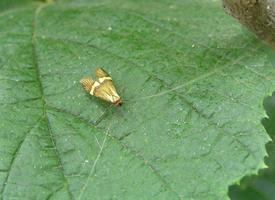
Állatleírás
The Longhorn moth, scientifically known as Nemophora degeerella, is a captivating species of moth that belongs to the Adelidae family, often referred to as fairy longhorn moths due to their delicate appearance and remarkably long antennae. This species is named after the Swedish naturalist Charles De Geer, paying homage to his contributions to entomology.Nemophora degeerella is predominantly found across Europe and parts of Asia, thriving in a variety of habitats including woodlands, grasslands, and gardens. The moth exhibits a striking appearance, which makes it quite distinguishable from other moth species. One of the most notable features of Nemophora degeerella is its exceptionally long antennae, which can extend up to three times the length of its body in males, serving as a fascinating characteristic during mating displays. Females also boast long antennae, though not as elongated as their male counterparts.
The wingspan of Nemophora degeerella typically ranges between 14 to 18 millimeters. The forewings display a beautiful golden-yellow hue with distinct black markings, which can vary slightly among individuals. These colors not only serve as camouflage among the foliage but also play a role in attracting mates. The hindwings are narrower and less colorful, aiding in swift, agile flight.
The lifecycle of the Longhorn moth is equally intriguing. Females lay their eggs on the leaves of their host plants, which predominantly include various species of deciduous trees and shrubs. Upon hatching, the larvae feed on the leaves, undergoing several developmental stages before pupating. The caterpillars are known to construct a protective cocoon from silk and leaf particles, within which they metamorphose into the adult moth form. This process is closely tied to the seasons, with adults typically emerging in late spring to early summer, ready to begin the cycle anew.
Nemophora degeerella plays a vital role in its ecosystem, serving as both a pollinator and a source of food for predators. The adult moths are known to feed on nectar from a variety of flowers, contributing to the pollination process. Meanwhile, the larvae provide nourishment for a range of insectivorous animals, highlighting the moth's integral position in the food web.
In conclusion, the Longhorn moth, Nemophora degeerella, is a fascinating and beautiful insect that captivates the attention of both scientists and nature enthusiasts alike. Its unique physical characteristics, interesting lifecycle, and role in the ecosystem make it a noteworthy subject of study and admiration in the natural world.
Új állatfotók
Top 10 állat
- Diana monkey (Cercopithecus diana)
- Dolphin gull (Leucophaeus scoresbii)
- Galápagos tortoise (Geochelone nigra complex)
- Moustached guenon (Cercopithecus cephus)
- Japanese spider crab (Macrocheira kaempferi)
- Colossal squid (Mesonychoteuthis hamiltoni)
- Stone loach (Barbatula barbatula)
- Common house mosquito (Culex pipiens)
- Common reed warbler (Acrocephalus scirpaceus)
- Sea urchins (Echinoidea)